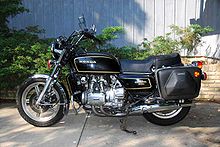Sport touring motorcycle

Sport touring refers to either a style of motorcycle design, or a philosophy of riding. It is an attempt to blend performance with long-distance capabilities while providing comfort and relative safety to the rider. Sport touring has evolved over decades from simply strapping a bag to the back of any sporty motorcycle to a very specified genre of motorcycle riding for which specific models of motorcycles, luggage, riding apparel and other accessories have been designed.
Across the globe, motorcycle touring has become very popular as riders traverse thousands of miles on two wheels. The Honda Goldwing was instrumental in causing this surge in long-distance touring and all other major Japanese and European motorcycle manufacturers have joined in to produce large touring motorcycles to vie for touring honors with the Goldwing. The most extreme examples of long-distance riding in the U. S. today are the activities of the Iron Butt Association.
Sport touring motorcycles



For the majority of the sport-tourer models on the market, it has been common for the manufacturer to utilize an existing engine and technology from the current or last generation of their sport bikes. This is cost effective because of the reuse of existing tooling and parts,rather than creating a dedicated engine design from scratch.
Differences vis-à-vis sport bikes
As a result, engine designs were usually modified from their sport bike origins, typically being re-tuned and re-cammed (change of valve cam lift & duration) for an emphasis on greater mid-range torque rather than absolute peak horsepower. Additionally, it was common for certain rotating subcomponents such as crankshaft and flywheel to be replaced in the sport-tourer version of the engine with heavier versions to accommodate smoother power delivery and potentially higher reliability factors. Other differences from the sportbike class include:
- Larger fairings than are implemented on their sport-bikes are usually added for more rider protection from weather & wind.
- The frame is usually designed from scratch to provide a more upright/less aggressive riding position ("all day comfortable").
- A longer wheelbase & more relaxed steering angle are usually also incorporated (both of which provide more straight-line stability than their sport bike origins, but not to the degree that most pure tourers do). The addition of these heavier parts (full fairings, longer frames, heavier engine components) also serve to increase the sprung weight of the motorcycle, which increases the sprung-vs-unsprung weight ratios, giving the bikes smoother riding characteristics over poor surfaces than the sporting motorcycles they usually derive from.
- Finally, ground clearance is usually left fairly high, permitting more sport-like riding through non-linear roads than the pure tourer segment.
However, the class has become important and competitive enough that many manufactures now offer purpose-built engines for their sport touring models. The Honda ST series engines have never been used in any other models. The Yamaha FJR1300's engine, though closely related to the 1000cc R1 sport bike engines in design, is in fact a dedicated engine available only in the sport touring FJR models. Soon, Kawasaki will introduce a new 1400cc Concours with a dedicated engine design.
Sport-tourers tend to install accessories, called farkles, to better enjoy the ride.
Examples of sport-touring motorcycles
Sport-touring riders

Most sport touring riders also have a riding life outside of their travels. Weekend rides with friends, commuting or just running an errand on two wheels may also put miles on a sport-touring rider's odometer.
Sport-touring aficionados tend to disdain those who only ride their motorcycle a few miles to a restaurant on a sunny Sunday, and some feel outright contempt for any able-bodied person who would trailer their motorcycle behind a pick-up truck to attend a rally. Though a very diverse bunch in other aspects of their lives, what unites sport-tourers is their relentless pursuit of the perfect road -- be it in their backyard or across the continent.
Yet, sport touring is truly a frame of mind more so than a product appellation. Sport tourers come in all flavors, and whether riding an ST-specific motorcycle or their old "beater" with a duffle bag strapped to the seat, it's the ride that matters. It's not the destination, but the journey. A sport-tourer seeks out beautiful scenery, interesting (or just plain weird) attractions and most important of all -- twisty roads. A sport-tourer's path between Point A and Point B is seldom a straight line; it's often the most convoluted possible.
Lastly, sport tourers are often recognized by the gear they wear. A favorite motto is ATGATT: "All the gear, all the time," which means the sport-touring motorcyclist will not ride in shorts and a t-shirt. When a non-rider asks "Aren't you hot in all that gear?", a good standard reply is "Well, thanks for noticing..."
Adventure touring

Another motorcycle activity that has become popular is "adventure touring." Spurred on, if not initiated, by BMW's introduction in 1981 of the R80G/S, adventure touring has caused other manufacturers to produce their own motorcycles for this purpose.
One of the more popular of these bikes is the Kawasaki KLR650, due to its economical price, its longevity on the market, and the KLR650's ubiquitousness.
